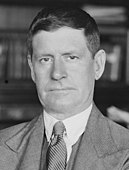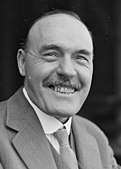| ||||||||||||||||||||||||||||||||||
All 90 seats in the New South Wales Legislative Assembly 46 Assembly seats were needed for a majority | ||||||||||||||||||||||||||||||||||
|---|---|---|---|---|---|---|---|---|---|---|---|---|---|---|---|---|---|---|---|---|---|---|---|---|---|---|---|---|---|---|---|---|---|---|
| ||||||||||||||||||||||||||||||||||
 Two-candidate-preferred margin by electorate | ||||||||||||||||||||||||||||||||||
| ||||||||||||||||||||||||||||||||||
The 1927 New South Wales state election to elect the 90 members of the 28th Legislative Assembly was held on 8 October 1927. During the previous parliament the voting system, Single transferable voting, a form of proportional representation with multi-member seats (modified Hare-Clark), had been changed to single member constituencies and Instant-runoff voting (optional preferential voting).[1][2][3]
Severe divisions occurred within the Labor Party caucus in the four months prior to the election (see Lang Labor). A caretaker government composed of the supporters of the Premier of New South Wales and party leader, Jack Lang was in power at the time of the election.[4]
As a result of the election the Lang government was defeated and a Nationalist/Country Party coalition government led by Thomas Bavin[5] and Ernest Buttenshaw[6] was formed with a parliamentary majority of 1 and the usual support of the 2 Nationalist independents. The Parliament first met on 3 November 1927, and ran its maximum term of 3 years. Lang remained the leader of the Labor Party throughout the Parliament.
- ^ Cite error: The named reference
Green 1927was invoked but never defined (see the help page). - ^ "Part 5B alphabetical list of all electorates and Members since 1856" (PDF). NSW Parliamentary Record. Parliament of New South Wales. Retrieved 20 April 2020.
- ^ "Former members of the New South Wales Parliament, 1856–2006". New South Wales Parliament. Retrieved 4 December 2019.
- ^ Nairn, Bede. "Lang, John Thomas (Jack) (1876–1975)". Australian Dictionary of Biography. Canberra: National Centre of Biography, Australian National University. ISBN 978-0-522-84459-7. ISSN 1833-7538. OCLC 70677943. Retrieved 2 November 2021.
- ^ McCarthy, John. "Bavin, Sir Thomas Rainsford (Tom) (1874–1941)". Australian Dictionary of Biography. Canberra: National Centre of Biography, Australian National University. ISBN 978-0-522-84459-7. ISSN 1833-7538. OCLC 70677943. Retrieved 6 May 2019.
- ^ Kingston, Beverley. "Buttenshaw, Ernest Albert (1876–1950)". Australian Dictionary of Biography. Canberra: National Centre of Biography, Australian National University. ISBN 978-0-522-84459-7. ISSN 1833-7538. OCLC 70677943. Retrieved 23 November 2021.

